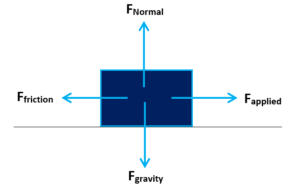To solve the problem using principles of work and energy, we consider the system comprising the two masses. We know that one mass will move up while the other moves down, and we’re given the displacement d = 0.8 meters for each mass.
Assuming the 12 kg mass moves downward and the 9 kg mass moves upward, we need to find the common velocity v after they have moved 0.8 meters, taking into account that energy is conserved in this isolated system (ignoring air resistance and friction). Here’s the step-by-step analysis:
| Step | Derivation/Formula | Reasoning |
|---|---|---|
| 1 | m_1 = 12 \, \text{kg} m_2 = 9 \, \text{kg} |
Define the masses where m_1 is the 12 kg mass and m_2 is the 9 kg mass. |
| 2 | g = 9.81 \, \text{m/s}^2 | Acceleration due to gravity is g . |
| 3 | \Delta h = 0.8 \, \text{m} | Both masses displace by 0.8 m, one moving up and the other down. |
| 4 | U_{\text{initial}} = 0 \, \text{J} | Initial potential energy is set to zero for simplicity as we’re only interested in changes. |
| 5 | U_{\text{final}} = -m_1 g \Delta h + m_2 g \Delta h | Final potential energy obtained by considering the gain in height by m_2 and loss in height by m_1 . |
| 6 | U_{\text{final}} = -12 \times 9.81 \times 0.8 + 9 \times 9.81 \times 0.8 | Substitute the known values to find U_{\text{final}} . |
| 7 | U_{\text{final}} = -23.544 \, \text{J} | Calculate the final potential energy. |
| 8 | KE_{\text{initial}} = 0 \, \text{J} | Initial kinetic energy, assuming they start from rest. |
| 9 | KE_{\text{final}} = \frac{1}{2} (m_1 + m_2) v^2 | Kinetic energy for the system of the two moving masses at the final state. |
| 10 | KE_{\text{final}} = \frac{1}{2} (12+9) v^2 | Expression for the final kinetic energy of both masses. |
| 11 | KE_{\text{final}} = 10.5 v^2 | Simplifying the expression for final kinetic energy. |
| 12 | KE_{\text{final}} = -U_{\text{final}} | By conservation of energy, change in potential energy equals change in kinetic energy. |
| 13 | 10.5 v^2 = 23.544 | Substitute computed value of U_{\text{final}} . |
| 14 | v^2 = \frac{23.544}{10.5} | Solve for v^2 . |
| 15 | v = \sqrt{\frac{23.544}{10.5}} | Calculate v . |
| 16 | v \approx 1.49 \, \text{m/s} | Final velocity of the masses after traveling 0.8 m. |
This result indicates the common speed of both masses after they have moved 0.8 meters, based on the conservation of mechanical energy.
Phy can also check your working. Just snap a picture!

The box in the diagram is sliding to the right across a horizontal table, under the influence of the forces shown. Which force(s) is doing negative work on the box?
A block of mass m is moving on a horizontal frictionless surface with a speed v_0 as it approaches a block of mass 2m which is at rest and has an ideal spring attached to one side.
When the two blocks collide, the spring is completely compressed and the two blocks momentarily move at the same speed, and then separate again, each continuing to move.
A horizontal force of 110 N is applied to a 12 kg object, moving it 6 m on a horizontal surface where the kinetic friction coefficient is 0.25. The object then slides up a 17° inclined plane. Assuming the 110 N force is no longer acting on the incline, and the coefficient of kinetic friction there is 0.45, calculate the distance the object will slide on the incline.
A boulder is raised above the ground so that its potential energy is 550 J. Then it is dropped. Assuming 92 J of energy was lost to air resistance, what is the kinetic energy of the boulder just before it hits the ground?
Two balls are dropped from the roof of a building. One ball has twice as massive as the other and air resistance is negligible. Just before hitting the ground, the more massive ball has ball ____ the kinetic energy of the less massive ball.
1.49 m/s
By continuing you (1) agree to our Terms of Sale and Terms of Use and (2) consent to sharing your IP and browser information used by this site’s security protocols as outlined in our Privacy Policy.
| Kinematics | Forces |
|---|---|
| \Delta x = v_i t + \frac{1}{2} at^2 | F = ma |
| v = v_i + at | F_g = \frac{G m_1m_2}{r^2} |
| a = \frac{\Delta v}{\Delta t} | f = \mu N |
| R = \frac{v_i^2 \sin(2\theta)}{g} |
| Circular Motion | Energy |
|---|---|
| F_c = \frac{mv^2}{r} | KE = \frac{1}{2} mv^2 |
| a_c = \frac{v^2}{r} | PE = mgh |
| KE_i + PE_i = KE_f + PE_f |
| Momentum | Torque and Rotations |
|---|---|
| p = m v | \tau = r \cdot F \cdot \sin(\theta) |
| J = \Delta p | I = \sum mr^2 |
| p_i = p_f | L = I \cdot \omega |
| Simple Harmonic Motion |
|---|
| F = -k x |
| T = 2\pi \sqrt{\frac{l}{g}} |
| T = 2\pi \sqrt{\frac{m}{k}} |
| Constant | Description |
|---|---|
| g | Acceleration due to gravity, typically 9.8 , \text{m/s}^2 on Earth’s surface |
| G | Universal Gravitational Constant, 6.674 \times 10^{-11} , \text{N} \cdot \text{m}^2/\text{kg}^2 |
| \mu_k and \mu_s | Coefficients of kinetic (\mu_k) and static (\mu_s) friction, dimensionless. Static friction (\mu_s) is usually greater than kinetic friction (\mu_k) as it resists the start of motion. |
| k | Spring constant, in \text{N/m} |
| M_E = 5.972 \times 10^{24} , \text{kg} | Mass of the Earth |
| M_M = 7.348 \times 10^{22} , \text{kg} | Mass of the Moon |
| M_M = 1.989 \times 10^{30} , \text{kg} | Mass of the Sun |
| Variable | SI Unit |
|---|---|
| s (Displacement) | \text{meters (m)} |
| v (Velocity) | \text{meters per second (m/s)} |
| a (Acceleration) | \text{meters per second squared (m/s}^2\text{)} |
| t (Time) | \text{seconds (s)} |
| m (Mass) | \text{kilograms (kg)} |
| Variable | Derived SI Unit |
|---|---|
| F (Force) | \text{newtons (N)} |
| E, PE, KE (Energy, Potential Energy, Kinetic Energy) | \text{joules (J)} |
| P (Power) | \text{watts (W)} |
| p (Momentum) | \text{kilogram meters per second (kgm/s)} |
| \omega (Angular Velocity) | \text{radians per second (rad/s)} |
| \tau (Torque) | \text{newton meters (Nm)} |
| I (Moment of Inertia) | \text{kilogram meter squared (kgm}^2\text{)} |
| f (Frequency) | \text{hertz (Hz)} |
General Metric Conversion Chart
Example of using unit analysis: Convert 5 kilometers to millimeters.
Start with the given measurement: \text{5 km}
Use the conversion factors for kilometers to meters and meters to millimeters: \text{5 km} \times \frac{10^3 \, \text{m}}{1 \, \text{km}} \times \frac{10^3 \, \text{mm}}{1 \, \text{m}}
Perform the multiplication: \text{5 km} \times \frac{10^3 \, \text{m}}{1 \, \text{km}} \times \frac{10^3 \, \text{mm}}{1 \, \text{m}} = 5 \times 10^3 \times 10^3 \, \text{mm}
Simplify to get the final answer: \boxed{5 \times 10^6 \, \text{mm}}
Prefix | Symbol | Power of Ten | Equivalent |
|---|---|---|---|
Pico- | p | 10^{-12} | 0.000000000001 |
Nano- | n | 10^{-9} | 0.000000001 |
Micro- | µ | 10^{-6} | 0.000001 |
Milli- | m | 10^{-3} | 0.001 |
Centi- | c | 10^{-2} | 0.01 |
Deci- | d | 10^{-1} | 0.1 |
(Base unit) | – | 10^{0} | 1 |
Deca- or Deka- | da | 10^{1} | 10 |
Hecto- | h | 10^{2} | 100 |
Kilo- | k | 10^{3} | 1,000 |
Mega- | M | 10^{6} | 1,000,000 |
Giga- | G | 10^{9} | 1,000,000,000 |
Tera- | T | 10^{12} | 1,000,000,000,000 |
The most advanced version of Phy. Currently 50% off, for early supporters.
per month
Billed Monthly. Cancel Anytime.
Trial –> Phy Pro
A quick explanation
UBQ credits are specifically used to grade your FRQs and GQs.
You can still view questions and see answers without credits.
Submitting an answer counts as 1 attempt.
Seeing answer or explanation counts as a failed attempt.
Lastly, check your average score, across every attempt, in the top left.
MCQs are 1 point each. GQs are 1 point. FRQs will state points for each part.
Phy can give partial credit for GQs & FRQs.
Phy sees everything.
It customizes responses, explanations, and feedback based on what you struggle with. Try your best on every question!
Understand you mistakes quicker.

For GQs and FRQs, Phy provides brief feedback as to how you can improve your answer.
Aim to increase your understadning and average score with every attempt!
10 Free Credits To Get You Started
*Phy Pro members get unlimited credits

By continuing you agree to nerd-notes.com Terms of Service, Privacy Policy, and our usage of user data.